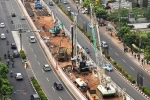The trap of infrastructure development
This article has been translated by PwC Indonesia as part of our Indonesia Infrastructure News Service. PwC Indonesia has not checked the accuracy of, and accepts no responsibility for the content.
Investor Daily - Jebakan pembangunan infrastruktur
16 August 2023
By: Dhenny Yuartha Junifta
Many have written that a massive infrastructure development is required for a sustainable economic growth. In the context of achieving the Golden Indonesia 2045 vision, the decision to develop was determined to improve connectivity. The hypothesis is that connectivity is the foundation of even distribution and boosted growth performance.
Hence, there are massive investments disbursed to support the infrastructure development agenda. In the 2015-2019 National Medium-Term Development Plan (RPJMN), the total funds required to develop infrastructure reach around Rp4.7 thousand trillion. Meanwhile, in the 2020-2024 RPJMN, the total reaches around Rp6.4 thousand trillion. However, with the government’s planned investment rate, there is a significant financing gap reaching around 42%.
Amid the investment gap, funding from overseas is required to close the gap. Cooperation with other countries to construct infrastructure is carried out massively. Incentives and ease of regulations have been offered, especially to attract foreign investors to enter sectors that are financially less attractive.
Starting point of the trap
Various efforts are implemented by the government to boost the massive infrastructure development. State-owned enterprises (SOEs) are assigned to support the agenda. The initial step taken was diverting the fuel subsidy. More than Rp200 trillion from the fuel subsidy budget was diverted at the start of President Joko Widodo’s administration. So, in the early period, infrastructure budget significantly increased from Rp256 trillion in 2015 to Rp381 trillion in 2017.
The increase in infrastructure budget in the early period has benefited construction SOEs economically. Contracts assigned to construction SOEs have increased. For example, Waskita Karya’s new contract value increased significantly from Rp22 trillion in 2014 to Rp55 trillion in 2017. Construction SOEs are also aggressively providing financing by making corporate loans. A debt-to-equity ratio that is in the double digits becomes normal for construction SOEs.
After 2019, infrastructure development was still carried out massively even though the fiscal capacity had started to go down. The government’s infrastructure budget grew stagnant. Furthermore, the Covid-19 pandemic knocked infrastructure off the top of the priority list.
Hence, windfalls for construction SOEs start to plummet. The equity growth does not match the increase in debts. The gearing ratio is at a concerning level. For example, the ratio of Waskita Karya reaches 200%. It means that the profit of the company is very low, but their interest expense is very high. Corporations that are at this ratio level are more prone to default and bankruptcy.
Funding trap
Infrastructure development ambition, funding gap, and risk mismanagement are the triad of funding traps. Several traps that can spring up are related to the risk of using public funds to finance projects that are not financially feasible. So, the state budget (APBN) is required to recover the unhealthy finances of SOEs. It can be seen from the use of public funds to provide state equity participation (PMN) for unhealthy SOEs. For example, Hutama Karya has been provided more than Rp100 trillion in PMN from 2017 to 2023.
The use of public funds outside of the APBN mechanism can also be implemented through a rights issue. In practice, companies with a high gearing ratio will carry out rights issues to dilute their debt value. It is why Waskita Karya has been aggressively carrying out rights issues in the last several years.
The government’s load related to the APBN will increase if the rights issues are not absorbed by the market, but they are absorbed by the government through PMN. The condition means two things, first, public shares are diluting so that the state’s ownership structure will increase. Then, the state’s ownership of companies with unhealthy finances will increase the state’s burden. It means larger SOE loss will increase the burden of the government. At this point, risks that were initially outside of the APBN’s load will be directly the APBN’s burden.
Other traps include the geopolitical pressure and the debt trap. These traps spring up due to the limited public funds that have to be used to respond to the investment requirement. On the other hand, there are investment disparities between sectors that are economically feasible and sectors that are not. Amid the limited public funds, projects such as high-end housing, energy, and telecommunications projects are more attractive to investors as they offer better returns. Different from infrastructure, rail-based projects, roads (including toll roads, especially the ones in areas with low mobility), and bridges lack investors.
This is where geopolitical pressure occurs. On the one hand, the investment requirement of projects with low returns are pushing the government to look for financing sources from other countries. On the other hand, there is competition in infrastructure financing to improve market access, resources, and political dominance in developing countries.
However, geopolitical and economic competitions are often used to finance projects that has less than favourable financial feasibility. Moreover, if the infrastructure projects are initiated due to political interests of the investing country with technical, environmental, and social tests. This condition will produce fiscal debts that are prone to default. The construction of Jakarta-Bandung High-speed Railway is one of the examples of the funding trap.
Financing for the construction is set to use bonds of the consortium or corporate loans. However, PMN is eventually used. Rather than the project progressing quickly, the project is tangled by bureaucracies and political interests of the investing country (China). Besides that, a cost overrun has occurred. The large burden that is carried by the SOEs to bear this project will also add to the state’s financial risk.
Infrastructure development is essential to boost connectivity and sustain growth. To realise the Golden Indonesia 2045 vision, it is required. However, fiscal risks cannot be put aside. The financing traps have risks. The fiscal space is quite tight to bear an unsustainable infrastructure financing. Besides that, debts can also suppress the budget allocation for human capital development. The government needs to recalculate the direction of infrastructure development in the future.


















